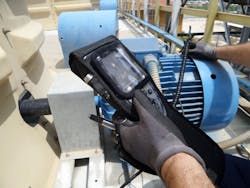How do you use vibration analysis in your maintenance shop? The answer from the typical shop would be something like: “We check motors during a PM to see if they have balance issues.” That’s typically a pass or fail test performed with an entry level handheld vibration tester. Not much analysis there.
Using a fully featured vibration analyzer, a properly trained technician can read the vibration signature. The tech knows not just the total vibration, but what that particular signature is indicating about why that motor is vibrating the way it is.
Got some bad vibration? Follow up with ultrasonic analysis, which will allow a qualified technician to predict with reasonable accuracy how many more months any damaged bearings have left before failure. That months-long notice provides ample time to schedule a repair, providing a huge cost advantage over competitors who lack this capability.
Vibration analysis is for more than just motors. You can also evaluate the health of your circuit breakers with this technology. The testing methods involve operating the breaker to obtain its first trip vibration signature. Contact a qualified testing firm about performing this during your next shutdown.
About the Author

Mark Lamendola
Mark is an expert in maintenance management, having racked up an impressive track record during his time working in the field. He also has extensive knowledge of, and practical expertise with, the National Electrical Code (NEC). Through his consulting business, he provides articles and training materials on electrical topics, specializing in making difficult subjects easy to understand and focusing on the practical aspects of electrical work.
Prior to starting his own business, Mark served as the Technical Editor on EC&M for six years, worked three years in nuclear maintenance, six years as a contract project engineer/project manager, three years as a systems engineer, and three years in plant maintenance management.
Mark earned an AAS degree from Rock Valley College, a BSEET from Columbia Pacific University, and an MBA from Lake Erie College. He’s also completed several related certifications over the years and even was formerly licensed as a Master Electrician. He is a Senior Member of the IEEE and past Chairman of the Kansas City Chapters of both the IEEE and the IEEE Computer Society. Mark also served as the program director for, a board member of, and webmaster of, the Midwest Chapter of the 7x24 Exchange. He has also held memberships with the following organizations: NETA, NFPA, International Association of Webmasters, and Institute of Certified Professional Managers.
